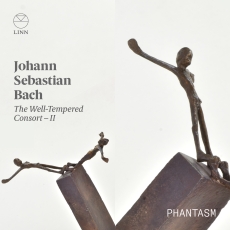Phantasm - J.S. Bach: The Well-Tempered Consort – II - Fanfare
For almost three decades, Phantasm have been at the forefront of the period- instrument movement. The ensemble’s recordings have drawn consistent praise, including a Diapson d’Or and several Gramophone awards. The Well-Tempered Consort-II is the second volume in a series of arrangements for viol consort of Bach’s preludes and fugues from The Well-Tempered Clavier on Linn. Like its predecessor, this disc features a program drawn from Books 1 and 2. Because the viol consort has a relatively homogeneous sound, like the keyboard instruments for which these preludes and fugues were written, they translate very well in these reworkings. Indeed, it doesn’t seem fair to call them simply “transcriptions” or “arrangements,” given the sensitivity with which the gambists have brought the music to life, and “reworkings” seems to be the best way to describe them. There are several advantages to realizing these pieces with a viol consort, chief among them the warmth the instruments bring to cool contrapuntal lines that can sometimes seem a bit too objective. The ability of each instrument to shape lines independently is also a key benefit, one of which the players take full advantage. This is especially important given that, of the 24 selections, all but six are fugues. I tend to prefer these works as complete pairs, and I’ve gravitated naturally toward those items. Of these, the preludes and fugues in G Minor, BWV 885, C♯ Minor, BWV 873, and D Major, BWV 874, are among the best selections on the album. The players are keen to contrast the freedom of the preludes with the rigidity of the fugues, each movement complementing the other to amplify the whole. Of the disembodied fugues, the Fugue No. 8 in D♯ Minor, BWV 853, is a standout, which Phantasm has transposed down a semitone. It would be disingenuous to deny that the pieces on this recording sound similar, but close listening reveals that the players approach each item individually and offer subtle, intelligent readings of each one. More important, these are consistently fine performances in conception and execution.

